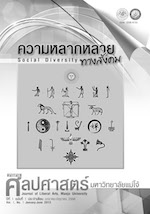ความเครียดของนักศึกษามหาวิทยาลัย (Stress among Students in University)
Main Article Content
Abstract
การศึกษาเชิงพรรณนาครั้งนี้มีวัตถุประสงค์เพื่อศึกษาและเปรียบเทียบระดับความเครียดของนักศึกษาที่มี เพศ สถานภาพสมรส ชั้นปีที่ศึกษา คณะและรายได้ที่แตกต่างกัน ประชากรคือนักศึกษามหาวิทยาลัยแห่งหนึ่งสุ่มตัวอย่างแบบชั้นภูมิ ได้จำนวนตัวอย่าง 674 คน ใช้แบบสอบถามและแบบวัดความเครียดสวนปรุง วิเคราะห์ข้อมูลด้วยสถิติเชิงพรรณนา การทดสอบที และการวิเคราะห์ความแปรปรวนแบบทางเดียว
ผลการศึกษา พบกลุ่มตัวอย่างเป็นหญิงมากกว่าชายประมาณ 3 เท่า ศึกษาระดับปริญญาตรีภาคปกติ ร้อยละ 73.3 ปริญญาตรีภาคสมทบ ร้อยละ 13.9 สถานภาพโสด ร้อยละ 96.7 ศึกษาในคณะเศรษฐศาสตร์ มนุษยศาสตร์ และสังคมศาสตร์ ศึกษาศาสตร์ และวิทยาศาสตร์ ใกล้เคียงกัน (ร้อยละ 22.8, 22.4, 20.6, 18.0 ตามลำดับ) ร้อยละ 57.6 ของกลุ่มตัวอย่าง มีความเครียดในระดับสูง ร้อยละ 22.1 เครียดระดับรุนแรง และร้อยละ 19.1 เครียดระดับปานกลางความเครียดในระดับเล็กน้อยพบร้อยละ 1.2 ชายและหญิงมีความเครียดไม่แตกต่างกันทุกระดับการศึกษามีความเครียดในระดับสูง ยกเว้นนักศึกษาปริญญาโทภาคปกติเครียดระดับปานกลาง ค่าเฉลี่ยความเครียดมีความสัมพันธ์ทางลบกับรายได้ระดับความเครียดจากสูงไปต่ำ พบดังนี้ คณะนิติศาสตร์ มนุษยศาสตร์และสังคมศาสตร์ เศรษฐศาสตร์และบริหารธุรกิจ เทคโนโลยีและการพัฒนาชุมชนศิลปกรรมศาสตร์ ศึกษาศาสตร์ และ สุขภาพและการกีฬา นักศึกษาที่มีสถานภาพสมรสต่างกันมีค่าเฉลี่ยระดับความเครียดแตกต่างกันอย่างมีนัยสำคัญทางสถิติ (p<.01) โดยที่ผู้ที่สมรสแล้วเครียดน้อยกว่าผู้ที่เป็นโสด และแต่ละชั้นปีมีความเครียดแตกต่างกัน โดยพบว่า ชั้นปีที่ 3 และปีที่ 4 มีความเครียดมากกว่าปี 1 และ ปี 2 อย่างมีนัยสำคัญทางสถิติ (p<.01)
ผลจากการศึกษาครั้งนี้ แสดงให้เห็นว่านักศึกษามีภาวะเครียด ควรเร่งหากลวิธีลดความเครียดให้แก่นักศึกษาที่มีระดับความเครียดรุนแรงและสูง จัดระบบดูแลส่งเสริมและป้องกันปัญหาสุขภาพจิต เช่น การจัดให้มีหน่วยบริการให้การปรึกษาของคณะ ในรูปแบบพี่ช่วยน้อง เพื่อให้นักศึกษาสามารถเข้าถึงบริการ การจัดกิจกรรมการเรียนการสอนที่สอดแทรกการผ่อนคลายหรือลดความเครียด เพิ่มศักยภาพอาจารย์ที่ปรึกษาในการใช้เทคนิคการให้การปรึกษาเบื้องต้น จัดกิจกรรมผ่อนคลายสภาพแวดล้อมที่ผ่อนคลาย และกำหนดให้มีระบบคัดกรองและเฝ้าระวังปัญหาสุขภาพจิตของนักศึกษาก่อนเข้าเรียน เพื่อลดภาวะเครียดพัฒนาคุณภาพชีวิตและป้องกันปัญหาสุขภาพจิตให้กับนักศึกษาต่อไป
Stress among Students in University
This descriptive study was aimed to evaluate the level of stress among the students and compare stress level in difference gender, marital status, study year, faculty, and incomes. Stratified randomization was applied to enroll samples from the university students. The enrollment was done during June and August 2004. Suanprung stress Test was applied.Results:
Most of the samples enrolled were female students (3 times more than male students). The students of bachelor level in the regular program were the majority of the samples (73.3%), followed by the students in the extended program, (13.9%). Most of them were single (96.7%). Average monthly salary was less than 5,000 bath. They studied in the faculty of economics. Human and social sciences, educations and sciences in 22.8,22.4,20.6 and 18.0 respectively. The faculty of technologies and community development had the least sample number (2.1%).
More than half the students had high level of stress (57.6%). Severe stress was found in 22.1% and moderate stress was 19.1%. Only 1.2% of the students had mild stress. There was no difference between both genders in accompanying high level of stress. Students of all the level of the study year had high level of stress except for the master degree students of the regular program who had moderate level of stress. The author found that mean value of stress was negatively correlated with the income. The level of stress in order from high to low was as below: the faculty of law, human and social sciences, economics and business administration, technologies and community development, arts, educations and health and sports science. The married students had significant lower level of stress (p<.01) and so was the employed students (p<.001).
Conclusions:
Methods to reduce stress among the university students is necessary. Promotion of good mental health by setting counseling unit in each faculty, peer or senior supports, integration of relaxation techniques in class study, enhance the consultant instructors’ ability in counseling including relax corners and activities may be useful. Screening and surveillance of mental health problems among the students should be the policy of the university to promote the healthy mind and prevent the mental health problems among the students.

